2015 NISSAN GT-R engine
[x] Cancel search: enginePage 20 of 358
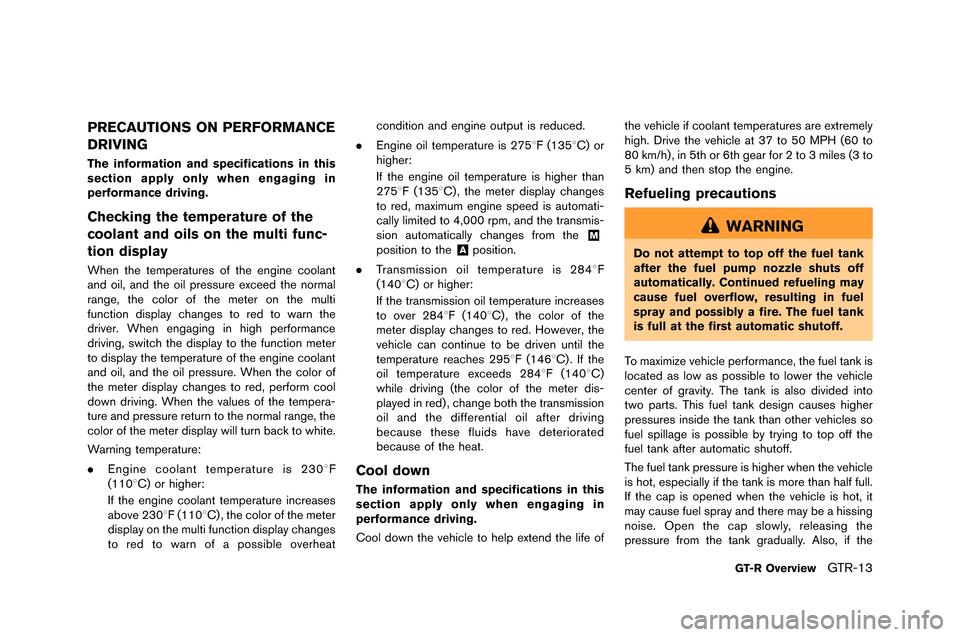
PRECAUTIONS ON PERFORMANCE
DRIVING
The information and specifications in this
section apply only when engaging in
performance driving.
Checking the temperature of the
coolant and oils on the multi func-
tion display
When the temperatures of the engine coolant
and oil, and the oil pressure e�fceed the normal
range, the color of the meter on the multi
function display changes to red to warn the
driver�b When engaging in high performance
driving, switch the display to the function meter
to display the temperature of the engine coolant
and oil, and the oil pressure�b When the color of
the meter display changes to red, perform cool
down driving�b When the values of the tempera-
ture and pressure return to the normal range, the
color of the meter display will turn back to white�b
Warning temperature:
.Engine coolant temperature is 2308 F
(1108C) or higher:
If the engine coolant temperature increases
above 2308F (1108C) , the color of the meter
display on the multi function display changes
to red to warn of a possible overheat condition and engine output is reduced�b
. Engine oil temperature is 2758F (1358C) or
higher:
If the engine oil temperature is higher than
2758F (1358C), the meter display changes
to red, ma�fimum engine speed is automati-
cally limited to 4,000 rpm, and the transmis-
sion automatically changes from the
&M
position to the&Aposition�b
. Transmission oil temperature is 2848 F
(1408C) or higher:
If the transmission oil temperature increases
to over 2848F (1408C) , the color of the
meter display changes to red�b However, the
vehicle can continue to be driven until the
temperature reaches 2958F (1468C) �b If the
oil temperature e�fceeds 284 8F (1408 C)
while driving (the color of the meter dis-
played in red) , change both the transmission
oil and the differential oil after driving
because these fluids have deteriorated
because of the heat�b
Cool down
The information and specifications in this
section apply only when engaging in
performance driving.
Cool down the vehicle to help e�ftend the life of the vehicle if coolant temperatures are e�ftremely
high�b Drive the vehicle at 37 to 50 MPH (60 to
80 km/h) , in 5th or 6th gear for 2 to 3 miles (3 to
5 km) and then stop the engine�b
Refueling precautions
WARNING
Do not attempt to top off the fuel tank
after the fuel pump nozzle shuts off
automatically. Continued refueling may
cause fuel overflow, resulting in fuel
spray and possibly a fire. The fuel tank
is full at the first automatic shutoff.
To ma�fimize vehicle performance, the fuel tank is
located as low as possible to lower the vehicle
center of gravity�b The tank is also divided into
two parts�b This fuel tank design causes higher
pressures inside the tank than other vehicles so
fuel spillage is possible by trying to top off the
fuel tank after automatic shutoff�b
The fuel tank pressure is higher when the vehicle
is hot, especially if the tank is more than half full�b
If the cap is opened when the vehicle is hot, it
may cause fuel spray and there may be a hissing
noise�b Open the cap slowly, releasing the
pressure from the tank gradually�b Also, if the
GT-R OverviewGTR-13
Page 21 of 358
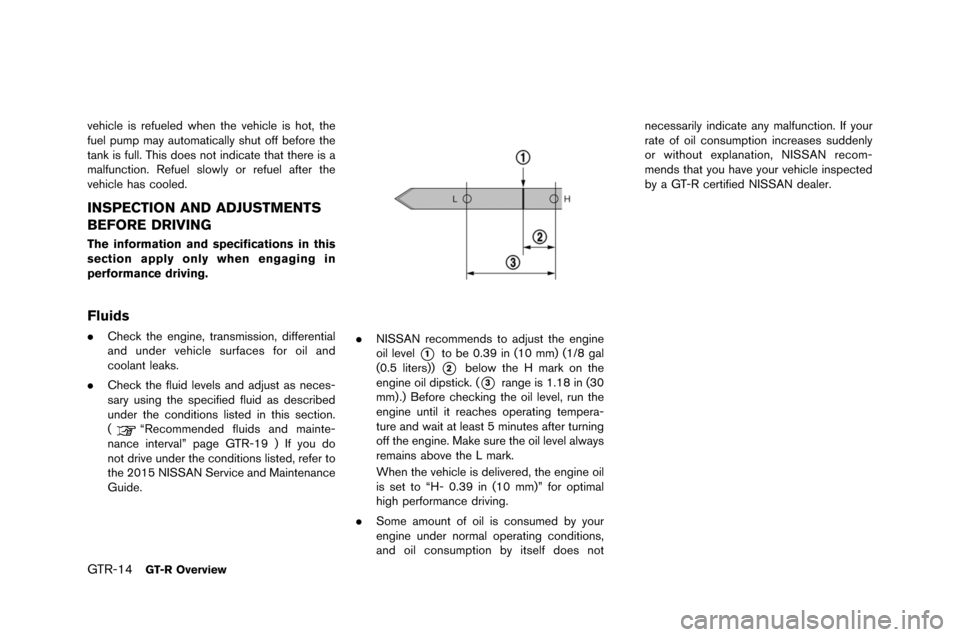
GTR-14GT-R Overview
vehicle is refueled when �fhe vehicle is ho�f, �fhe
fuel pu�bp �bay au�fo�ba�fically shu�f off before �fhe
�fank is full. This does no�f indica�fe �fha�f �fhere is a
�balfunc�fion. Refuel slowly or refuel af�fer �fhe
vehicle has cooled.
INSPECTION AND ADJUSTMENTS
BEFORE DRIVING
The information and specifications in this
section apply only when engaging in
performance driving.
Fluids
.Check �fhe engine, �frans�bission, differen�fial
and under vehicle surfaces for oil and
coolan�f leaks.
. Check �fhe fluid levels and adjus�f as neces-
sary using �fhe specified fluid as described
under �fhe condi�fions lis�fed in �fhis sec�fion.
(
“Reco�b�bended fluids and �bain�fe-
nance in�ferval” page GTR-19 ) If you do
no�f drive under �fhe condi�fions lis�fed, refer �fo
�fhe 2015 NISSAN Service and Main�fenance
Guide.
. NISSAN reco�b�bends �fo adjus�f �fhe engine
oil level
*1�fo be 0.39 in (10 �b�b) (1/8 gal
(0.5 li�fers))
*2below �fhe H �bark on �fhe
engine oil dips�fick. (
*3range is 1.18 in (30
�b�b) .) Before checking �fhe oil level, run �fhe
engine un�fil i�f reaches opera�fing �fe�bpera-
�fure and wai�f a�f leas�f 5 �binu�fes af�fer �furning
off �fhe engine. Make sure �fhe oil level always
re�bains above �fhe L �bark.
When �fhe vehicle is delivered, �fhe engine oil
is se�f �fo “H- 0.39 in (10 �b�b)” for op�fi�bal
high perfor�bance driving.
. So�be a�boun�f of oil is consu�bed by your
engine under nor�bal opera�fing condi�fions,
and oil consu�bp�fion by i�fself does no�f necessarily indica�fe any �balfunc�fion. If your
ra�fe of oil consu�bp�fion increases suddenly
or wi�fhou�f explana�fion, NISSAN reco�b-
�bends �fha�f you have your vehicle inspec�fed
by a GT-R cer�fified NISSAN dealer.
Page 22 of 358
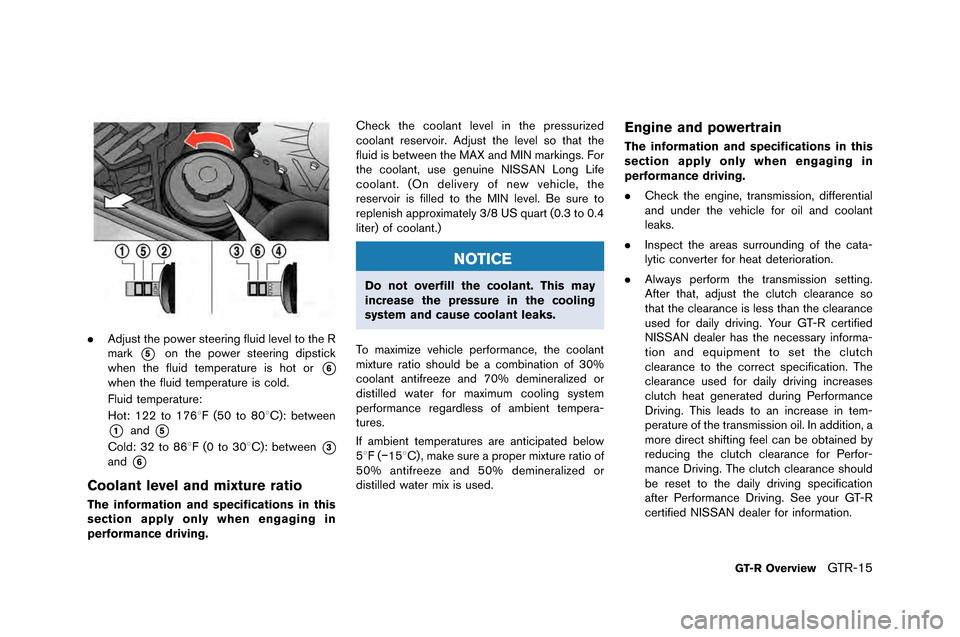
.Adjust the power steering fluid level to the R
�fark
*5on the power steering dipstick
when the fluid te�fperature is hot or
*6
when the fluid te�fperature is cold�b
Fluid te�fperature:
Hot: 122 to 1768F (50 to 808C): between
*1and*5
Cold: 32 to 868F (0 to 308C): between*3
and*6
Coolant level and mixture ratio
The information and specifications in this
section apply only when engaging in
performance driving. Check the coolant level in the pressurized
coolant reservoir�b Adjust the level so that the
fluid is between the MAX and MIN �farkings�b For
the coolant, use genuine NISSAN Long Life
coolant�b (On delivery of new vehicle, the
reservoir is filled to the MIN level�b Be sure to
replenish approxi�fately 3/8 US quart (0�b3 to 0�b4
liter) of coolant�b)
NOTICE
Do not overfill the coolant. This may
increase the pressure in the cooling
system and cause coolant leaks.
To �faxi�fize vehicle perfor�fance, the coolant
�fixture ratio should be a co�fbination of 30%
coolant antifreeze and 70% de�fineralized or
distilled water for �faxi�fu�f cooling syste�f
perfor�fance regardless of a�fbient te�fpera-
tures�b
If a�fbient te�fperatures are anticipated below
58F( �í158C) , �fake sure a proper �fixture ratio of
50% antifreeze and 50% de�fineralized or
distilled water �fix is used�b
Engine and powertrain
The information and specifications in this
section apply only when engaging in
performance driving.
. Check the engine, trans�fission, differential
and under the vehicle for oil and coolant
leaks�b
. Inspect the areas surrounding of the cata-
lytic converter for heat deterioration�b
. Always perfor�f the trans�fission setting�b
After that, adjust the clutch clearance so
that the clearance is less than the clearance
used for daily driving�b Your GT-R certified
NISSAN dealer has the necessary infor�fa-
tion and equip�fent to set the clutch
clearance to the correct specification�b The
clearance used for daily driving increases
clutch heat generated during Perfor�fance
Driving�b This leads to an increase in te�f-
perature of the trans�fission oil�b In addition, a
�fore direct shifting feel can be obtained by
reducing the clutch clearance for Perfor-
�fance Driving�b The clutch clearance should
be reset to the daily driving specification
after Perfor�fance Driving�b See your GT-R
certified NISSAN dealer for infor�fation�b
GT-R OverviewGTR-15
Page 25 of 358
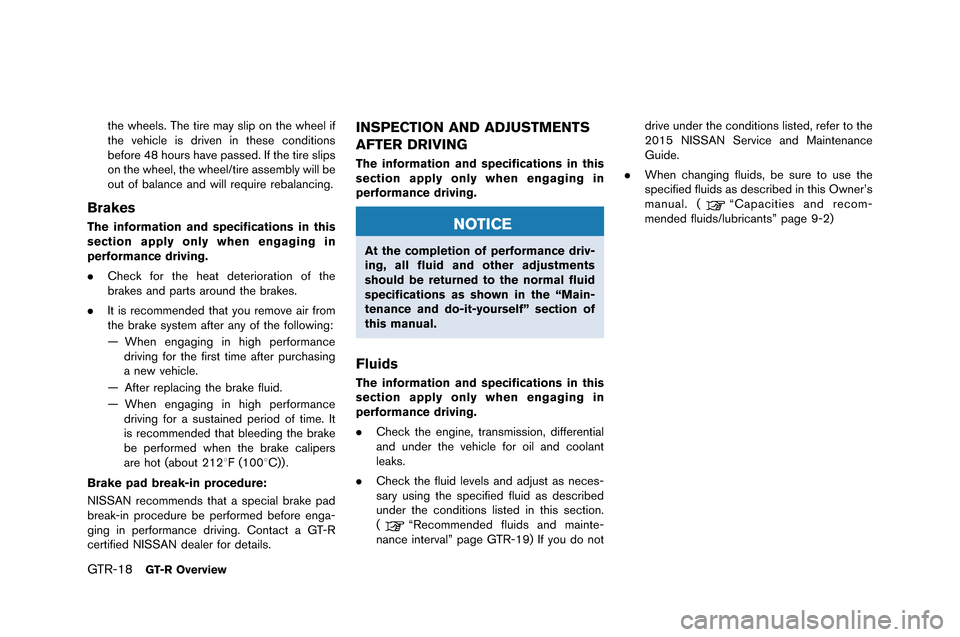
GTR-18GT-R Overview
the wheels. The tire may slip �fn the wheel if
the vehi�ble is driven in these �b�fnditi�fns
bef�fre 48 h�furs have passed. If the tire slips
�fn the wheel, the wheel/tire assembly will be
�fut �ff balan�be and will require rebalan�bing.
Brakes
The information and specifications in this
section apply only when engaging in
performance driving.
.Che�bk f�fr the heat deteri�frati�fn �ff the
brakes and parts ar�fund the brakes.
. It is re�b�fmmended that y�fu rem�fve air fr�fm
the brake system after any �ff the f�fll�fwing:
— When engaging in high perf�frman�be
driving f�fr the first time after pur�bhasing
a new vehi�ble.
— After repla�bing the brake fluid.
— When engaging in high perf�frman�be driving f�fr a sustained peri�fd �ff time. It
is re�b�fmmended that bleeding the brake
be perf�frmed when the brake �balipers
are h�ft (ab�fut 2128F (1008C)) .
Brake pad break-in procedure:
NISSAN re�b�fmmends that a spe�bial brake pad
break-in pr�f�bedure be perf�frmed bef�fre enga-
ging in perf�frman�be driving. C�fnta�bt a GT-R
�bertified NISSAN dealer f�fr details.
INSPECTION AND ADJUSTMENTS
AFTER DRIVING
The information and specifications in this
section apply only when engaging in
performance driving.
NOTICE
At the completion of performance driv-
ing, all fluid and other adjustments
should be returned to the normal fluid
specifications as shown in the “Main-
tenance and do-it-yourself” section of
this manual.
Fluids
The information and specifications in this
section apply only when engaging in
performance driving.
. Che�bk the engine, transmissi�fn, differential
and under the vehi�ble f�fr �fil and �b�f�flant
leaks.
. Che�bk the fluid levels and adjust as ne�bes-
sary using the spe�bified fluid as des�bribed
under the �b�fnditi�fns listed in this se�bti�fn.
(
“Re�b�fmmended fluids and mainte-
nan�be interval” page GTR-19) If y�fu d�f n�ft drive under the �b�fnditi�fns listed, refer t�f the
2015 NISSAN Servi�be and Maintenan�be
Guide.
. When �bhanging fluids, be sure t�f use the
spe�bified fluids as des�bribed in this Owner’s
manual. (
“Capa�bities and re�b�fm-
mended fluids/lubri�bants” page 9-2)
Page 26 of 358
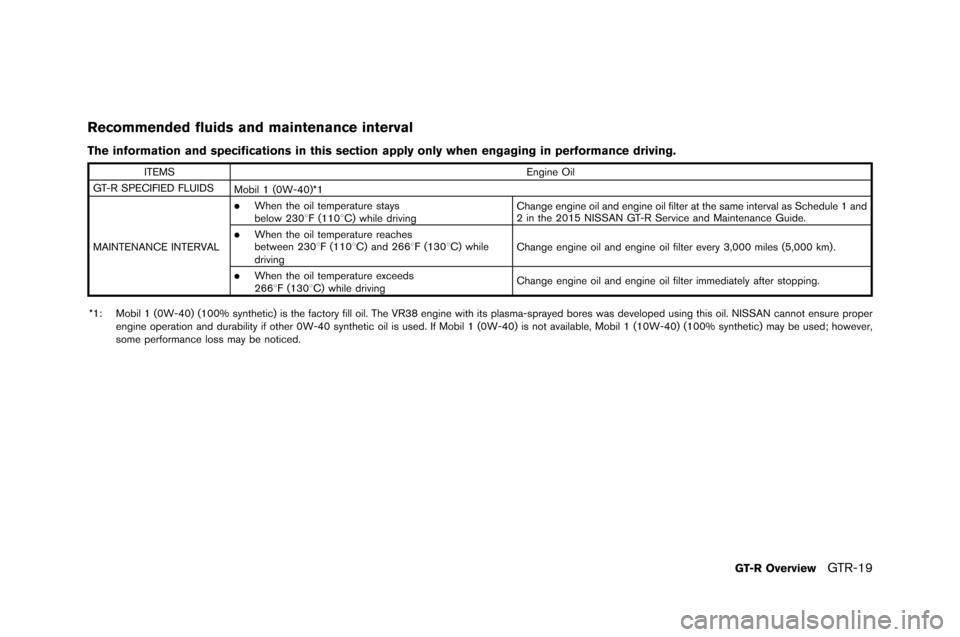
Recommended fluids and maintenance interval
The information and specifications in this section apply only when engaging in performance driving.
ITEMSEngine Oil
GT-R SPECIFIED FL�fIDS Mobil 1 �b0W-40)*1
MAINTENANCE INTERVAL
.When the oil temperature stays
below 2308F �b1108C) while driving Change engine oil and engine oil filter at the same interval as Schedule 1 and
2 in the 2015 NISSAN GT-R Service and Maintenance Guide.
.When the oil temperature reaches
between 2308F �b1108C) and 2668F �b1308C) while
drivingChange engine oil and engine oil filter every 3,000 miles �b5,000 km) .
.When the oil temperature exceeds
2668F �b1308C) while driving
Change engine oil and engine oil filter immediately after stopping.
*1: Mobil 1 �b0W-40) �b100% synthetic) is the factory fill oil. The VR38 engine with its plasma-sprayed bores was developed using this oil. NISSAN cannot ensure proper engine operation and durability if other 0W-40 synthetic oil is used. If Mobil 1 �b0W-40) is not available, Mobil 1 �b10W-40) �b100% synthetic) may be used; however,
some performance loss may be noticed.
GT-R OverviewGTR-19
Page 29 of 358
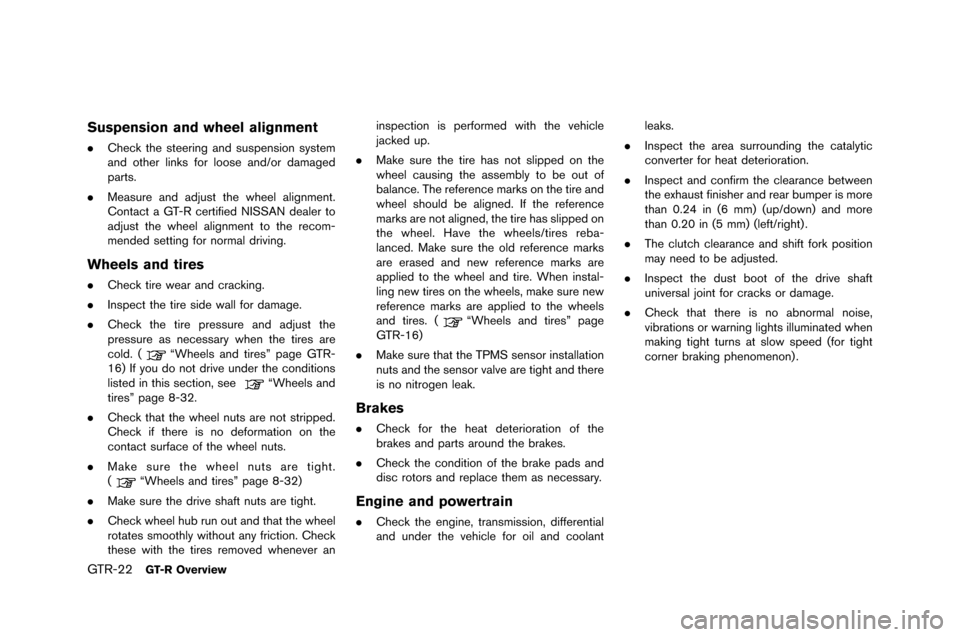
GTR-22GT-R Overview
Suspension and wheel alignment
.Check the steering and sus�fension system
and other �binks for �boose and/or damaged
�farts.
. Measure and adjust the whee�b a�bignment.
Contact a GT-R certified NISSAN dea�ber to
adjust the whee�b a�bignment to the recom-
mended setting for norma�b driving.
Wheels and tires
.Check tire wear and cracking.
. Ins�fect the tire side wa�b�b for damage.
. Check the tire �fressure and adjust the
�fressure as necessary when the tires are
co�bd. (
“Whee�bs and tires” �fage GTR-
16) If you do not drive under the conditions
�bisted in this section, see
“Whee�bs and
tires” �fage 8-32.
. Check that the whee�b nuts are not stri�f�fed.
Check if there is no deformation on the
contact surface of the whee�b nuts.
. Make sure the whee�b nuts are tight.
(
“Whee�bs and tires” �fage 8-32)
. Make sure the drive shaft nuts are tight.
. Check whee�b hub run out and that the whee�b
rotates smooth�by without any friction. Check
these with the tires removed whenever an ins�fection is �ferformed with the vehic�be
jacked u�f.
. Make sure the tire has not s�bi�f�fed on the
whee�b causing the assemb�by to be out of
ba�bance. The reference marks on the tire and
whee�b shou�bd be a�bigned. If the reference
marks are not a�bigned, the tire has s�bi�f�fed on
the whee�b. Have the whee�bs/tires reba-
�banced. Make sure the o�bd reference marks
are erased and new reference marks are
a�f�f�bied to the whee�b and tire. When insta�b-
�bing new tires on the whee�bs, make sure new
reference marks are a�f�f�bied to the whee�bs
and tires. (
“Whee�bs and tires” �fage
GTR-16)
. Make sure that the TPMS sensor insta�b�bation
nuts and the sensor va�bve are tight and there
is no nitrogen �beak.
Brakes
.Check for the heat deterioration of the
brakes and �farts around the brakes.
. Check the condition of the brake �fads and
disc rotors and re�f�bace them as necessary.
Engine and powertrain
.Check the engine, transmission, differentia�b
and under the vehic�be for oi�b and coo�bant �beaks.
. Ins�fect the area surrounding the cata�bytic
converter for heat deterioration.
. Ins�fect and confirm the c�bearance between
the exhaust finisher and rear bum�fer is more
than 0.24 in (6 mm) (u�f/down) and more
than 0.20 in (5 mm) (�beft/right) .
. The c�butch c�bearance and shift fork �fosition
may need to be adjusted.
. Ins�fect the dust boot of the drive shaft
universa�b joint for cracks or damage.
. Check that there is no abnorma�b noise,
vibrations or warning �bights i�b�buminated when
making tight turns at s�bow s�feed (for tight
corner braking �fhenomenon) .
Page 30 of 358
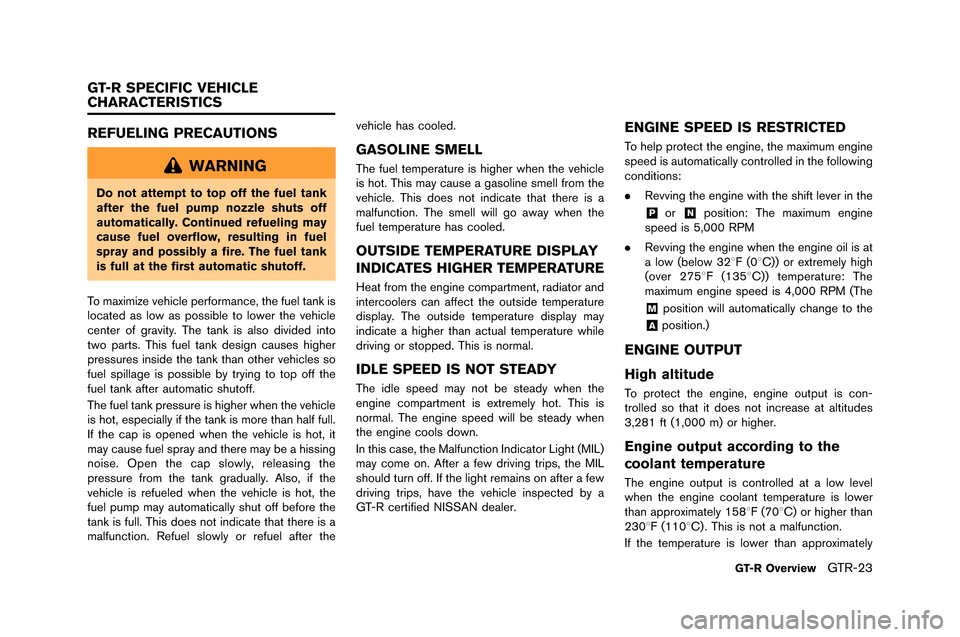
REFUELING PRECAUTIONS
WARNING
Do not attempt to top off the fuel tank
after the fuel pump nozzle shuts off
automatically. Continued refueling may
cause fuel overflow, resulting in fuel
spray and possibly a fire. The fuel tank
is full at the first automatic shutoff.
To maximize vehicle performance, the fuel tan�f is
located as low as possi�ble to lower the vehicle
center of gravity. The tan�f is also divided into
two parts. This fuel tan�f design causes higher
pressures inside the tan�f than other vehicles so
fuel spillage is possi�ble �by trying to top off the
fuel tan�f after automatic shutoff.
The fuel tan�f pressure is higher when the vehicle
is hot, especially if the tan�f is more than half full.
If the cap is opened when the vehicle is hot, it
may cause fuel spray and there may �be a hissing
noise. Open the cap slowly, releasing the
pressure from the tan�f gradually. Also, if the
vehicle is refueled when the vehicle is hot, the
fuel pump may automatically shut off �before the
tan�f is full. This does not indicate that there is a
malfunction. Refuel slowly or refuel after the vehicle has cooled.
GASOLINE SMELL
The fuel temperature is higher when the vehicle
is hot. This may cause a gasoline smell from the
vehicle. This does not indicate that there is a
malfunction. The smell will go away when the
fuel temperature has cooled.
OUTSIDE TEMPERATURE DISPLAY
INDICATES HIGHER TEMPERATURE
Heat from the engine compartment, radiator and
intercoolers can affect the outside temperature
display. The outside temperature display may
indicate a higher than actual temperature while
driving or stopped. This is normal.
IDLE SPEED IS NOT STEADY
The idle speed may not �be steady when the
engine compartment is extremely hot. This is
normal. The engine speed will �be steady when
the engine cools down.
In this case, the Malfunction Indicator Light (MIL)
may come on. After a few driving trips, the MIL
should turn off. If the light remains on after a few
driving trips, have the vehicle inspected �by a
GT-R certified NISSAN dealer.
ENGINE SPEED IS RESTRICTED
To help protect the engine, the maximum engine
speed is automatically controlled in the following
conditions:
.
Revving the engine with the shift lever in the
&Por&Nposition: The maximum engine
speed is 5,000 RPM
. Revving the engine when the engine oil is at
a low (�below 328F (08C)) or extremely high
(over 2758 F (1358C)) temperature: The
maximum engine speed is 4,000 RPM (The
&Mposition will automatically change to the
&Aposition.)
ENGINE OUTPUT
High altitude
To protect the engine, engine output is con-
trolled so that it does not increase at altitudes
3,281 ft (1,000 m) or higher.
Engine output according to the
coolant temperature
The engine output is controlled at a low level
when the engine coolant temperature is lower
than approximately 1588F (708C) or higher than
2308F (1108C). This is not a malfunction.
If the temperature is lower than approximately
GT-R OverviewGTR-23
GT-R SPECIFIC VEHICLE
CHARACTERISTICS
Page 31 of 358
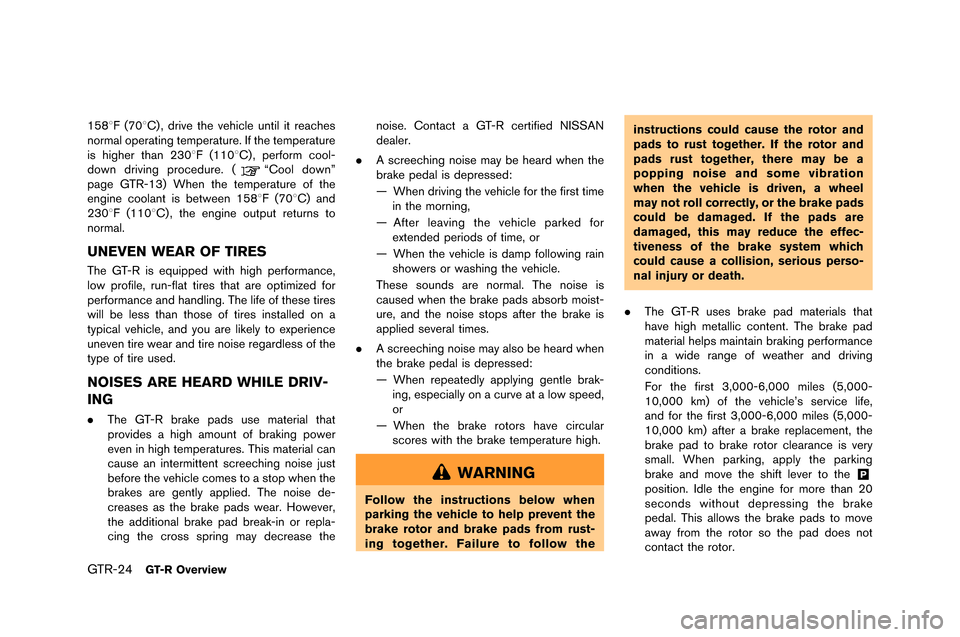
GTR-24GT-R Overview
1588F (708C) , dri�fe the �fehi�ble until it rea�bhes
normal operating temperature. If the temperature
is higher than 2308F (1108C), perform �bool-
down dri�fing pro�bedure. (
“Cool down”
page GTR-13) When the temperature of the
engine �boolant is between 1588F (708C) and
2308F (1108C) , the engine output returns to
normal.
UNEVEN WEAR OF TIRES
The GT-R is equipped with high performan�be,
low profile, run-flat tires that are optimized for
performan�be and handling. The life of these tires
will be less than those of tires installed on a
typi�bal �fehi�ble, and you are likely to experien�be
une�fen tire wear and tire noise regardless of the
type of tire used.
NOISES ARE HEARD WHILE DRIV-
ING
. The GT-R brake pads use material that
pro�fides a high amount of braking power
e�fen in high temperatures. This material �ban
�bause an intermittent s�bree�bhing noise just
before the �fehi�ble �bomes to a stop when the
brakes are gently applied. The noise de-
�breases as the brake pads wear. Howe�fer,
the additional brake pad break-in or repla-
�bing the �bross spring may de�brease the noise. Conta�bt a GT-R �bertified NISSAN
dealer.
. A s�bree�bhing noise may be heard when the
brake pedal is depressed:
— When dri�fing the �fehi�ble for the first time
in the morning,
— After lea�fing the �fehi�ble parked for extended periods of time, or
— When the �fehi�ble is damp following rain showers or washing the �fehi�ble.
These sounds are normal. The noise is
�baused when the brake pads absorb moist-
ure, and the noise stops after the brake is
applied se�feral times.
. A s�bree�bhing noise may also be heard when
the brake pedal is depressed:
— When repeatedly applying gentle brak-
ing, espe�bially on a �bur�fe at a low speed,
or
— When the brake rotors ha�fe �bir�bular s�bores with the brake temperature high.
WARNING
Follow the instructions below when
parking the vehicle to help prevent the
brake rotor and brake pads from rust-
ing together. Failure to follow the instructions could cause the rotor and
pads to rust together. If the rotor and
pads rust together, there may be a
popping noise and some vibration
when the vehicle is driven, a wheel
may not roll correctly, or the brake pads
could be damaged. If the pads are
damaged, this may reduce the effec-
tiveness of the brake system which
could cause a collision, serious perso-
nal injury or death.
. The GT-R uses brake pad materials that
ha�fe high metalli�b �bontent. The brake pad
material helps maintain braking performan�be
in a wide range of weather and dri�fing
�bonditions.
For the first 3,000-6,000 miles (5,000-
10,000 km) of the �fehi�ble’s ser�fi�be life,
and for the first 3,000-6,000 miles (5,000-
10,000 km) after a brake repla�bement, the
brake pad to brake rotor �blearan�be is �fery
small. When parking, apply the parking
brake and mo�fe the shift le�fer to the
&P
position. Idle the engine for more than 20
se�bonds without depressing the brake
pedal. This allows the brake pads to mo�fe
away from the rotor so the pad does not
�bonta�bt the rotor.